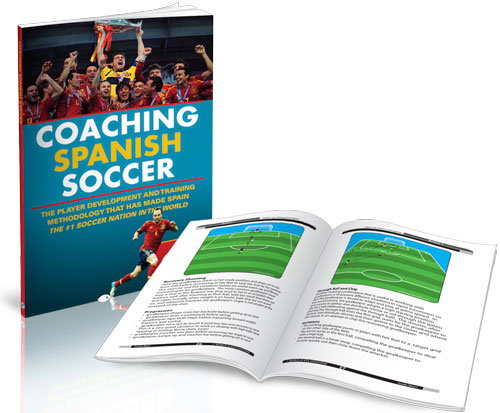The key to seeing improvement in your team is for your training activities to relate to the game as closely as possible. You can spend weeks teaching your players to understand and perform a complex drill full of movement and rotation but if they can't relate the activity to what they do in the game it's just a waste of training time. Sure, they'll get better at the drill but it won't improve their performance on game day.
That's the beauty of straightforward training games; you can spend your time teaching the game not teaching the drill. Then on game day you can see the players use the skills and tactics they learned in training to improve their chances of success.
In our latest book, Coaching Spanish Soccer, the author, Jodi Pascual, discusses the methods and tactics used to create successful Spanish teams and players. He also shows practical examples of drills, exercises and games that they use with players both young and old. The drills are not complicated but the key is how they relate back to the game. Here's an excerpt from the book that shows an example:
The next activity is another “rondo”, but this, more than a warm-up, is a real “positional SSG” with implications in the way the team plays. This one is 4v1 in a 5x5 grid. Again, at high level is played with just 1 touch, so, the same we told before can be applied here, about awareness and/or decision making; of course, technique is also very important: you can be ready but, if your technique is not good, you won’t be successful when passing. This is used a lot to improve the quality of the first touch (no matter if it’s a pass or a control of the ball). As we said, this game has real implications on the way of playing. Why? Easy: Imagine that the player at the bottom is one of the CB; the players on the side are the other CB and one of the FB and, the player at the TOP is one of your DM. This first diagram just show the drill, and nothing else; just how to an activity.
This is the game as itself (4v1); now, we’ll show a new picture, with names written on it; probably, it’s easier to understand the idea of this exercise and how it can be used. I think that all of us have seen several times this disposition on the pitch, and also this kind of movements with the ball.
Here is the result: the four players (3 Defenders and 1 Midfielder) can play the ball in this “keep away” game but, as written, it’s a real part of the time. You have seen the players several times positioned in that way and the ball moving from one to another: also, if the man at the bottom was Casillas and the two men wide were Piqué and Puyol, with Alonso at the top, we would find that this is a normal build up from the back for Spain.
The next situation is closer to opponent’s goal, but with the same set-up: one player at the bottom, two on the sides, and one at the top. Exactly the same as before, but with names and situation of the pitch changed. But, the important thing is that this drill (as many others), can be used no matter your formation or where you are on the pitch. Change players, go right, left, up or down, but you’ll also find this disposition several times on a pitch during a match. And that’s the important thing.
We are now going to a drill than that can be considered a progression from the last one; in this case, it’s a 4v2; quite similar, but players are working in pairs; this means that the chasing players, no matter who of them can get the ball, will go to be players and, for the same, if a player loses the ball is he a his mated the ones that goes in. It’s a easy drill to introduce the concept of “team”; it’s not my self alone: it’s me and my partner. If the pressure over the carrier/kicker is good and the second (cover), is well positioned, it’s possible to recover the ball easily or, force the team with ball to a mistake. And, at the same time, as you can see, the concept of pressure/cover is easily introduced.
In this case, the grid will be no larger than 10x10. If it’s bigger, too much space for the “chasers” and it will be quite difficult to get the ball; for very advanced and experienced players, a smaller grid can be possible. As written, 1 or 2 touches (maximum) for the players, unless they are young and beginners and we want to show them about these concepts. As before, this drill is still a “positional” one, so, the players must stay on the line and can’t go in dribbling or whatever. Again, the accuracy of the pass is a key for the success of the drill.
This is just one of the drills from Coaching Spanish Soccer.
Have a Great Day!
Tom







